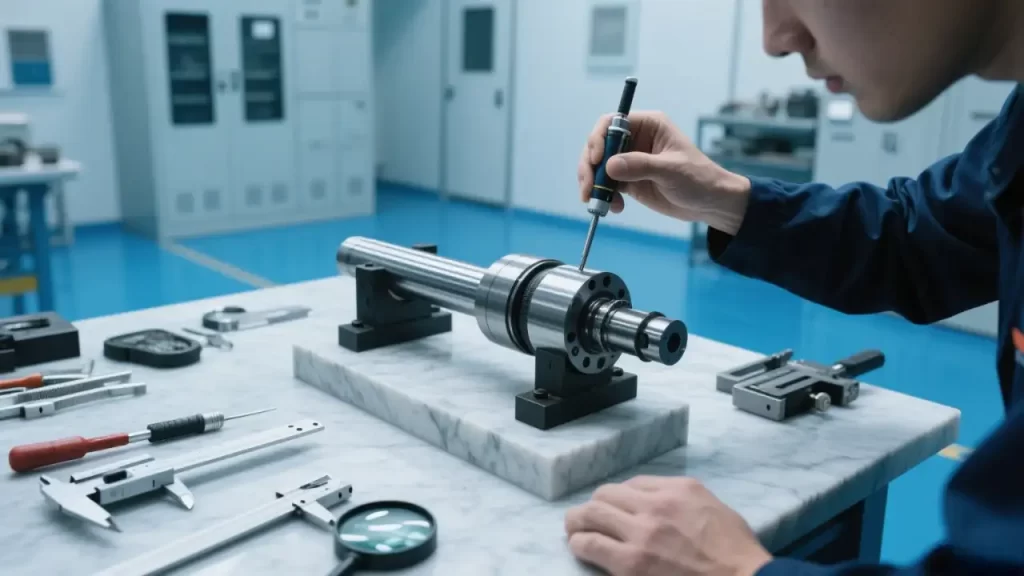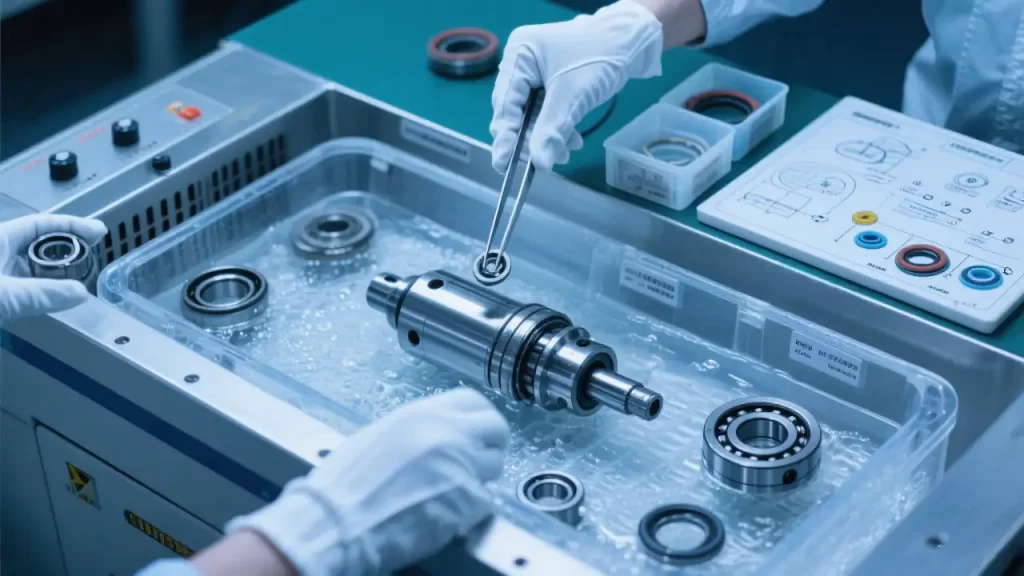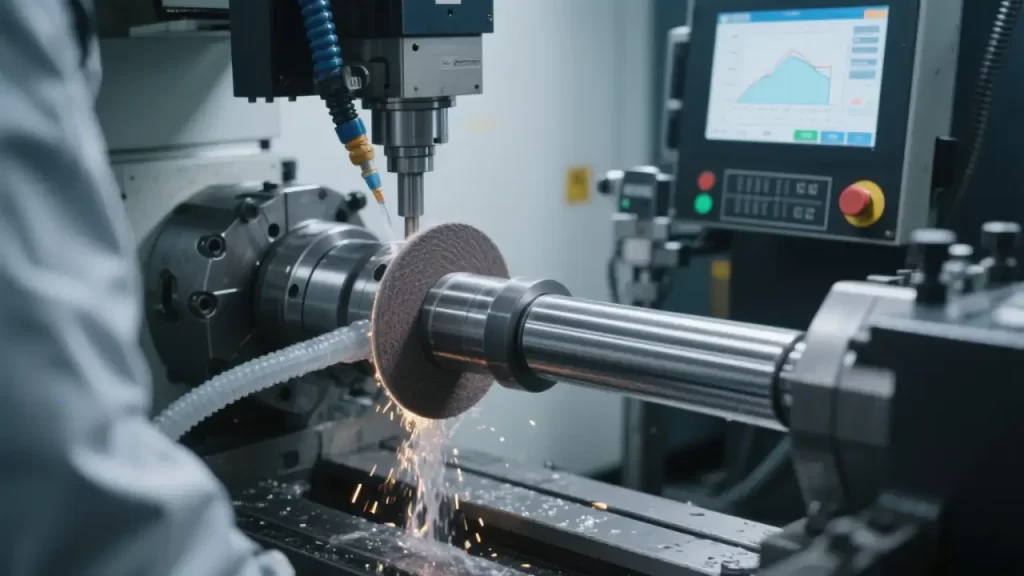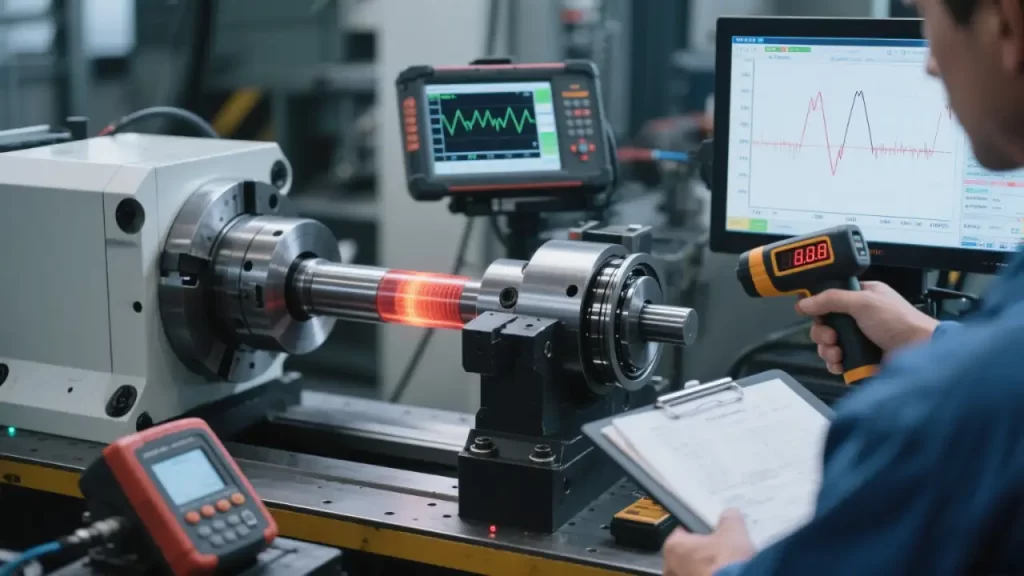What Is the CNC Spindle Repair Process
The CNC spindle is the core of a CNC machine, driving tools with high speed and stability for precise metal cutting and grinding in precision manufacturing. Wear, vibration, or faults from prolonged or improper use can reduce CNC machining quality. This article details the CNC spindle repair process, showing how professional repair restores performance and extends service life.
1. Initial Assessment
The first step in repairing a CNC spindle is a thorough assessment to identify symptoms and potential causes. This lays the foundation for subsequent repairs, ensuring all checks are evidence-based.

1.1 Receiving and Visual Inspection
Upon arrival at the repair workshop, the spindle’s packaging and exterior must be carefully inspected. Marks from transit, such as scratches on the housing or lubricant leaks, may hint at underlying issues. CNC equipment demands extreme precision, and even minor damage can affect performance. The repair team should photograph the spindle, log its serial number, and note initial observations, creating a detailed repair record. Standardized documentation aids traceability and provides clients with transparent repair evidence.
1.2 Client Communication
In-depth discussions with the client are crucial for understanding the issue. Technicians should inquire about the spindle’s performance during CNC machining, such as:
- Presence of unusual noise or vibration.
- Surface roughness or loss of precision in machined parts.
- Sudden stops or overheating.
These details help pinpoint potential causes, such as bearing wear, insufficient lubrication, or spindle imbalance. Clients may not use technical terms, but technicians must listen patiently to extract valuable clues.
1.3 Preliminary Damage and Contamination Check
Using a magnifying glass and surface roughness tester, inspect the spindle housing, shaft journal, and bearing cover for impact marks, cracks, or wear. Contamination is critical—cutting fluid, metal chips, or degraded grease can clog oil passages or corrode internal components. Technicians should note the color and odor of lubricant residue; metallic particles or a burnt smell may indicate prior overheating.
1.4 Tool and Environment Preparation
Assessments must occur in a dust-free environment to prevent secondary contamination. High-precision tools like calipers and dial indicators are used to measure critical dimensions, while cooling channels and oil passages are checked for blockages. The workshop should feature anti-static mats and sealed storage boxes to keep components clean. Environmental control is vital in CNC repair, as any oversight can lead to repair failure.
1.5 Initial Judgment and Planning
By combining visual inspections, client feedback, and measurement data, technicians can gauge the fault’s severity, determining whether parts need replacement or deeper repair. Findings, such as “0.02 mm scratches on the shaft journal” or “partially clogged oil passage,” must be logged. This information guides disassembly and further checks, preventing haphazard operations.
2. Disassembly
Disassembling a CNC spindle is akin to solving a precision puzzle, requiring utmost focus and skill. Rough handling risks damaging components, inflating repair costs.

2.1 Professional Component Disassembly
The spindle houses high-precision parts like bearings, rotors, and seals. Technicians use hydraulic pullers, thermal expansion kits, or specialized fixtures to dismantle components gradually. Movements must be gentle to avoid scratching the shaft journal or bearing raceways. For spindles with cooling tubes or sensors, technicians must document the layout of each tube and wire to ensure accurate reassembly.
2.2 Part Labeling and Organization
Every component—screws, washers, bearings—must be labeled with its origin, e.g., “front bearing cover screw #1.” Parts should be stored in labeled, sealed bags within a parts box. Technicians should photograph the disassembly sequence, sketch diagrams, or create 3D models to record part orientation and placement. CNC equipment components are intricate; losing or mixing them up halts repairs.
2.3 Part Cleaning
Disassembled parts are often coated in oil, chips, or burnt grease. An ultrasonic cleaner with eco-friendly agents restores parts to pristine condition. Cleaning reveals hidden issues, like pitting on bearing balls or aging seals. Cleaning fluid must be replaced regularly to avoid introducing new contaminants.
2.4 Maintaining a Dust-Free Environment
Disassembly and cleaning require a cleanroom setting. Tools must be wiped with lint-free cloths, and fixture surfaces kept smooth and burr-free. Cleaned parts should be stored in sealed boxes immediately to block dust. CNC system components are sensitive to tiny particles, which can shorten spindle life.
2.5 Initial Observations
Post-cleaning, technicians can inspect parts for visible issues, such as bearing wear marks or rotor surface burns. These findings are logged to inform subsequent checks, helping prioritize inspection areas and boost repair efficiency.
3. Detailed Inspection and Testing
After disassembly and cleaning, components undergo comprehensive inspection and precise measurements to uncover all potential issues.
3.1 Bearing and Seal Evaluation
Bearings, critical to spindle function, are checked for wear, cracks, or pitting on balls and raceways. A dial indicator measures inner and outer ring clearance, ensuring compliance with design tolerances (typically in microns). Seals are examined for aging, cracking, or wear, as failure risks lubricant leaks or contaminant ingress. Residual grease is analyzed; metallic debris suggests severe bearing wear.
3.2 Runout and Balance Testing
Smooth spindle operation hinges on minimal runout and optimal balance. Runout, the deviation at the spindle’s front during rotation, is measured with a dial indicator, keeping radial and axial errors below 0.002 mm. Balance testing uses a dynamic balancing machine to detect rotor imbalance. Poor balance causes vibration, reducing CNC machining accuracy and tool life.
3.3 Electrical Component Testing
For motorized spindles, technicians test motor winding insulation resistance to check for shorts or leaks. Encoder and sensor signals are verified with an oscilloscope for stability. Electrical faults can cause spindle stalling or data errors, requiring meticulous attention.
3.4 In-Depth Critical Component Check
The shaft journal is inspected under a microscope for micro-cracks or thermal damage, while cooling channels are probed with an endoscope for blockages or corrosion. The spindle housing’s threads and mating surfaces are measured for deformation or wear. Any defect in these parts can degrade post-assembly performance.
3.5 Data Logging and Analysis
Inspection data, such as “front bearing inner ring wear of 0.03 mm” or “rotor runout of 0.005 mm,” is recorded. Photos, videos, and measurement reports are archived for client transparency. Technicians analyze data to decide which parts can be repaired or must be replaced, hypothesizing causes like inadequate lubrication or overspeed operation.
4. Diagnosis
Post-inspection, data and client feedback are synthesized to pinpoint the fault’s root cause and devise a repair plan.
4.1 Fault Cause Analysis
Bearing wear may stem from insufficient lubrication, requiring checks for clogged oil passages or pump failure. Rotor imbalance could result from impact or prolonged wear, corroborated by runout data. Client reports of “odd noises during machining” may indicate poor gear meshing or overheating. Technicians must connect these dots to identify the core issue.
4.2 Documenting Diagnosis
Diagnosis details, such as “severe front bearing wear, replace with model XXX ceramic bearing” or “clogged lubrication system, clean oil passages,” are logged. The record includes part conditions, fault causes, and initial repair suggestions to guide subsequent steps.
4.3 Estimating Repair Scope
Based on the diagnosis, technicians list parts needing replacement (e.g., bearings, seals) and components requiring machining (e.g., shaft journal grinding). Labor hours and costs are estimated, with pros and cons of new versus repaired parts explained to the client. CNC machine parts can be costly, and transparent quotes build trust.
4.4 Crafting a Repair Plan
The repair plan specifies each step, e.g., “replace front bearing, then rebalance rotor to 0.002 mm tolerance.” Required tools, like a CNC surface grinder, and timelines are outlined to ensure efficient, orderly repairs. The plan accounts for client production needs, minimizing downtime.
5. Repair Execution
With a clear diagnosis, technicians replace parts, machine surfaces, and adjust balance to restore peak spindle performance.

5.1 Replacing Damaged Parts
Severely worn bearings are swapped for high-precision models, like ceramic bearings, while seals use high-temperature, wear-resistant materials. Damaged screws or washers are also replaced. Part selection aligns with spindle speed and load requirements for optimal performance.
5.2 Surface Machining and Restoration
Scratches on the shaft journal or rotor are repaired using a CNC surface grinder to restore original tolerances. Surface roughness is kept below Ra 0.2 microns to prevent frictional heat. Machining employs high-precision fixtures and quality coolant to avoid material stress changes.
5.3 Balance and Alignment
Repaired rotors are tested on a dynamic balancing machine, adjusted to an imbalance below 0.001 g·mm. Bearing seats and housing alignment are calibrated with laser tools, ensuring errors under 0.002 mm. Balance and alignment are pivotal for smooth operation and machining precision.
5.4 Quality Control
Each repair is remeasured—shaft journal diameter, rotor runout—and logged. Lubrication channels are tested for unobstructed flow. Replaced parts are photographed for client records. Quality control is the final safeguard, demanding precision.
6. Reassembly
Reassembly, the penultimate repair step, ensures components fit flawlessly.
6.1 Sequential Assembly
Using disassembly records, bearings, rotors, and housing are installed in order. A torque wrench secures screws to avoid over- or under-tightening. Dial indicators monitor concentricity and perpendicularity in real-time, ensuring tolerances are met. Cooling tubes and wires follow the original layout to prevent misplacement.
6.2 Lubrication and Sealing
Lubricant choice, like synthetic grease for high-speed spindles, is tailored to spindle speed, applied precisely. Seals are installed with specialized tools for a tight fit, preventing leaks or dust entry. Lubrication channels are tested to ensure even grease distribution to bearings and gears.
6.3 Alignment and Fit
Post-assembly, a laser alignment tool calibrates the rotor and housing, keeping errors below 0.002 mm. Bearing preload is adjusted with a torque meter for optimal tension. The spindle is rotated manually to confirm no sticking or unusual resistance.
6.4 Initial Checks
After assembly, key clearances, like between bearings and rotor, are measured, and seal conditions and screw tightness verified. Data, such as “rotor alignment error of 0.001 mm,” is logged. The assembly process is photographed to demonstrate proper execution.
7. Validation of Repair
The assembled spindle undergoes rigorous testing to confirm performance.

7.1 Operational Testing
Mounted on a test rig, the spindle ramps from low to maximum speed, mimicking CNC machining conditions. A vibration analyzer monitors vibrations, targeting below 0.01 mm/s. An infrared thermometer checks bearing and motor temperatures, stabilizing at 40-50°C after 30 minutes.
7.2 Noise and Runout
A properly running spindle is smooth and quiet. Abnormal noises prompt bearing or balance checks. A noise meter ensures decibel levels are safe. Runout tests are repeated, with radial and axial errors below 0.002 mm.
7.3 System Verification
Lubrication system pressure and flow are tested to confirm coverage of critical parts. Electrical components undergo current, voltage, and signal output checks for stability. Lubrication and electrical performance directly impact spindle longevity, requiring thorough validation.
7.4 Final Inspection
The spindle is partially disassembled to check bearings and seals for abnormal wear. An endoscope inspects oil and cooling channels for blockages. Test data is compared to manufacturer standards, generating a detailed report with vibration curves, temperature graphs, and runout figures. Reports and videos are archived for client review.
8. Return and Installation Guidance
The repaired spindle must be safely delivered with installation and maintenance support.
8.1 Secure Packaging
The spindle is packed in a custom foam box with shock-absorbing materials to prevent transit damage. A desiccant bag is included, and the box labeled “Fragile” and “Keep Dry.” Serial and repair numbers are marked for client verification.
8.2 Repair Documentation
Clients receive a repair report detailing replaced parts (e.g., “front ceramic bearing, model XXX”), operations (e.g., “shaft journal ground to 50.000 ± 0.002 mm”), and test data. Maintenance advice, like “check lubricant every 500 hours, use XXX grease,” is clear and user-friendly.
8.3 Installation Instructions
An installation guide specifies mounting torque (e.g., “screws at 20 Nm”) and alignment steps (e.g., “use dial indicator for concentricity, error below 0.003 mm”). Clients are advised to run at low speed for one hour, monitoring temperature and noise, before full-speed operation. Video tutorials can simplify the process.
8.4 After-Sales Support
Contact details are provided for installation or usage queries. Clients are encouraged to share periodic performance data, like vibration and temperature, for remote diagnostics. Quality after-sales service fosters trust and long-term partnerships.
9. Conclusion
CNC spindle repair is a technically demanding process involving precise measurements, component restoration, and performance validation. Professional repair significantly extends spindle life, reducing CNC machining downtime costs. Thorough repair is more cost-effective than frequent part replacements, ensuring sustained performance in precision manufacturing.
Repair is only the beginning; regular maintenance is vital. Clients should:
- Inspect Lubrication Systems Regularly: Replace grease and clean oil passages every 500 hours.
- Monitor Performance Data: Log vibration and temperature monthly, addressing anomalies promptly.
- Conduct Preventive Maintenance: Check bearings and seals every 1000 hours to preempt issues.
With scientific maintenance, CNC equipment maintains high efficiency, minimizing fault-related losses. Investing in repair and upkeep enhances machining quality and drives greater business value.



